4 Mi comunidad
Objectives
Communicative goals
- Identify and describe places in the community.
- Ask for and give directions.
- Make purchases.
- Express agreement and disagreement.
- Offer recommendations and opinions.
Cultural goals
- Research and present on notable places in the Spanish-speaking world.
- Become familiar with and compare different currencies in the Spanish-speaking world.
- Compare and contrast aspects of Spanish-speaking communities and students’ home communities.
I. Tira cómica
It’s market day! Ana goes to the farmers market and meets up with her neighbor, Señora Martínez.





Actividad 4.1. Comprensión
II. ¿Te fijaste que…? Las comunidades en el mundo hispano
Las tiendas y la práctica de comprar
Actividad 4.2. Las tiendas y la práctica de comprar
Conexión cultural: Las tiendas y las prácticas de comprar
Markets, or mercados, are both popular and important around the world. In Spanish-speaking communities across the globe, many residents shop at supermercados, or large grocery chains, as well as smaller, more local stores. Similar to the weekly farmers’ markets open during the warmer months in many communities in the United States, it is very common for local vendors to come together to sell their products on a set día de mercado. Unlike in the US, however, these days are rarely on Sundays, since, as you learned in chapter 3, Sundays are generally reserved for time with family. Other days of the week are shopping days, and it’s common to visit several shops several times per week rather than making one large trip to last for a week or even two.
Even amid the changes of globalization, in many parts of the world, small businesses still represent important parts of local economies and daily life for both residents and business owners. In much of the Spanish-speaking world, there are both large department store–style establishments similar to Walmart and smaller shops that specialize in one particular area and operate a small business selling a specific type of merchandise.
Because there are so many different types of specialized tiendas (stores), each one has its own name. Pan (bread) and other baked goods are sold at a panadería. A butcher, who sells carne (meat), owns or works at a carnicería. If you are looking for the laundromat where you would lavar (wash) your clothes, you go to a lavandería. Zapatos (shoes) are sold and repaired at a zapatería. Don’t forget about juguetes (toys), which are sold at a juguetería. While in English we often refer to these places with the word store (bookstore, for example), in Spanish, we use a version of the word itself and add on -ería. Where do you go to buy helado (ice cream)? An heladería, of course!
La cortesía en las tiendas
Actividad 4.3. La cortesía en las tiendas
Conexión cultural: La cortesía en las tiendas
Just like Ana greeted the fruit vendor, it is considered good manners to greet or otherwise acknowledge the workers present in a tienda as you enter and to say good-bye upon leaving. This is a practice that is very common in smaller, independently run stores, even in more urban areas with higher populations.
Whereas in the United States, there’s a cultural emphasis on “customer service” that privileges the client—you’ve certainly heard the adage “The customer is always right!”—in Spanish-speaking countries, there tends to be a more reciprocal relationship. Along with a personal greeting, it is common for employees and store owners to provide samples and also add a bit more to the purchase than the client has asked for and paid for. This used to be a standard practice in the United States—have you ever heard of a “baker’s dozen”?—but is no longer as common. This added extra has different names in different places, such as pilón (Mexico) or yapa (Chile, Argentina, Uruguay, Paraguay, Peru, Ecuador).
Las plazas y su calendario cultural
Actividad 4.4. Las plazas y su calendario cultural
Conexión cultural: Las plazas y su calendario cultural
In chapter 2, we discussed the importance of the plaza as a central meeting place for the community. Beyond simply serving as a place to meet and walk around, though, plazas are typically surrounded by, and some might even say composed of, a variety of shops, restaurants, bars, and open-air spaces for concerts and events. Many municipalities, regardless of size, maintain a cultural calendar with a variety of events and expositions that are open to the public. From concerts to lectures, plays, and festivals, plazas or town squares play host to a large quantity of activities that bring the community together. These sorts of traditions represent a cultural commonality between the United States and other Spanish-speaking countries more broadly, though of course, offerings vary from region to region.
Because of this use of the plaza or downtown area as a meeting space and the events and activities that take place there, many communities have a distinctive identity or “feel” that both defines them as distinctive from other localities and sets the tone for the kind of experience individuals will have there. Whether it’s a neighborhood, a district, or even an entire town, city, or region, many communities cultivate a particular identity that describes, shares, and promotes their unique features and values. This is true across the globe, though the ways in which communities cultivate and express their identities can vary greatly.
In many Spanish-speaking countries, given the influence of Catholicism, many communities celebrate their unique historical and cultural identity through celebrations related to their patron saint. Along with a multiday celebration or festival, community members often organize themselves into cofradías, or associations, that play a specific role in the unique ways in which the patron saint is venerated. Communities often pride themselves on the particular rituals involved in the celebration, which can be extremely specific to the local community.
Actividad de reflexión cultural 4.5. Conexión personal
Select one of the following topics to elaborate on in a detailed paragraph.
- Does your hometown or city have a special character? What makes it unique? When you are looking for something to do with your friends or family, do you have a community calendar to consult? What kinds of events does it include? Where do these events take place and what is their importance and value for you, your family, and the community at large?
- When you need to go shopping, do you tend to go to an almacén (big box store) or supermercado or a smaller local business or market? What factors influence your decision? What are the benefits and drawbacks of shopping at each type of store?
- What cultural practices do you engage in while shopping in order to be polite and courteous? What kind of behavior do you expect from store employees and other shoppers? Why might it be a good idea to take the time to acknowledge them as people before you move forward with your request?
Actividad de investigación cultural 4.6. El calendario cultural
What special celebrations or unique customs from Spanish-speaking countries have you heard about? Select one to research. If you need ideas, consider one of the following:
1. La Tomatina (España)
2. El Colacho (España)
3. El Día de los Muertos (México, Guatemala)
4. Las posadas navideñas (América Latina)
5. Inti Raymi (Perú)
6. La Feria de las Flores (Colombia)
Prepare a one- to two-minute presentation, in Spanish, on this celebration. Be sure to include the following information and one visual:
• ¿Cómo se llama la celebración?
• ¿Dónde tiene lugar?
• ¿Cuándo tiene lugar?
• ¿Por qué existe la celebración?
• ¿Cómo celebra la comunidad?
III. Ampliación: Las entregas al domicilio
Actividad de reflexión cultural 4.7. Los diferentes tipos de mercados
Answer the following questions in a few complete sentences.
When you think of your own personal shopping habits, do you think of going to stores, stands, and trucks or online shopping and mobile apps? Why? Do you expect that shopping in the Spanish-speaking world is similar to or different from your personal experience?
Actividad 4.8. Las entregas al domicilio
Read the following article about the growth of delivery companies in Latin America: https://labsnews.com/en/articles/business/delivery-sales-have-quadrupled-in-latin-america-over-the-last-five-years/.
Then use the information from the article to indicate whether the following statements are cierto o falso.
Actividad 4.9. Last-mile delivery
Now that you understand the importance of the food industry and food delivery in Latin America, read the following article, which provides more detail on investment in online sales and delivery services: https://restofworld.org/2022/mexico-delivery-apps-funding-survival/. Be sure to pay attention to the images that accompany the text.
Then use that information to answer the following questions:
- What do you think the word entregas means? (See the first photo.) How do you know?
- Why do you think Carlos Coronado calls his company Spidi?
- What app does Spidi rely on? Why is this a logical choice?
- What do PideDirecto, Jokr, and Jüsto have in common?
- How does Spidi differ from these other companies?
IV. Vocabulario
| Los lugares | Places | Vocabulario adicional relacionado con la comunidad | Additional vocabulary related to the community |
| El barrio
La estación de policía El hospital La clinica La farmacia La escuela / El colegio La universidad La cafeteríia El taller mecánico La gasolinera El parque infantil La iglesia El almacén El gimnasio El supermercado El mercado El centro comunitario El estadio El banco El aeropuerto La estación de autobuses/tren/metro El correo El museo El hotel El teatro El zoológico La sala de conciertos Panadería Joyería Nevería/heladería Taquería Zapatería Lavandería Tintorería Juguetería Mueblería |
The neighborhood
Police station Hospital Clinic Pharmacy School University Cafeteria Mechanic Gas station Playground Church Department store Gym Supermarket Market Community center Stadium Bank Airport Bus/train/metro station Post office Museum Hotel Theater Zoo Concert Hall Bakery Jewelry Store Ice cream parlor Taco shop Shoe store Laundromat Dry cleaner Toy store Furniture store |
El edificio
El estacionamiento La calle La avenida El policía El tráfico El embotellamiento La gasolina La multa El monumento El concierto El/la dependiente La tarjeta de crédito El efectivo La oferta cultural El espectáculo La medicina El antibiótico El analgésico El/la médico La carta El pan La carne La fruta Los vegetales La multa Misa La ropa Las joyas La obra de arte La obra de teatro El paquete El helado Boleto El cajero automático Al aire libre ayudar a Doblar Seguir (e→i) derecho o recto Asistir a un evento |
Building
Parking lot Street Avenue Police Traffic Traffic jam Gasoline Ticket/fine Monument Concert Store clerk Credit card Cash Cultural offering Show Medicine Antibiotic Painkiller Medic or doctor Letter Bread Meat Fruit Vegetables Fine/ticket Mass Clothing Jewelry Work of art Play Package Ice cream Ticket ATM Outside Help Turn Continue straight Attend an event |
| Preposiciones | Prepositions | Dar recomendaciones | Making recommendations |
| Para indicar localización
Abajo de Arriba de Alrededor de Entre Sobre Al lado de A la derecha de A la izquierda de Cerca de Lejos de Delante de Enfrente de Detrás de Dentro de Fuera de Encima de DeAbajo de Para indicar movimiento A En Desde Por Hacia Hasta |
To indicate location
Below On top of Around Between On Next to To the right of To the left of Close to Far from In front of In front of but facing each other Behind Inside Outside On top of Below To indicate movement To In, on, at Since, from By, around Toward Until |
Es importante + inf.
Es necesario + inf. Debes + inf. Recomiendo + inf. Aconsejar + inf. |
It is important to
It is necessary to You should I recommend I advise |
| Frases para mostrar acuerdo y desacuerdo | Phrases that indicate agreement or disagreement | Pronombres de objeto directo | Direct object pronouns |
| Estoy de acuerdo que…
Tienes razón Creo que estás en lo correcto Estoy seguro/a Me parece bien Yo también Yo tampoco Claro que sí Claro que no Está bien. Es cierto. (No) estoy de acuerdo que… Temo que no estoy de acuerdo No estoy seguro/a No me parece bien |
I agree that…
You are right I believe you are correct I am certain It seems fine to me Me too Me either Yes, of course No, of course not It is fine It is true I agree (do not) agree that… I am afraid that I do not agree… I am not sure… It doesn’t seem right to me |
Me
Te Lo La Nos Os Los Las |
Me
You Him, it (masc.) Her, it (fem.) Us You all Them (masc.) Them (fem.) |
Actividad 4.10. ¿Qué podemos comprar allí?
Actividad 4.11. ¿Dónde trabaja?
Read the following statements about what an individual does and then write the name of the place where that person works.
Modelo:
Vende muebles. Trabaja en una mueblería.
- Da multas de tráfico.
- Hace pan.
- Lleva cartas.
- Cocina tacos.
- Enseña a niños.
Actividad 4.12. ¿Qué o quién es?
Read the description and use the vocabulary list to indicate to what or whom it refers.
Modelo:
Son los eventos culturales que se ofrecen como conciertos, espectaculos y exposiciones.
Es la oferta cultural.
Actividad 4.13. El día ocupado de Ana
Actividad interpersonal 4.14. ¿Con qué frecuencia visitas estos lugares?
Paso 1—Indicate the frequency with which you visit the following places by putting an X in the box that best describes your habits.
| Lugar | Siempre | Frecuentemente | Algunas veces | Nunca o casi nunca |
| La tintorería | ||||
| El correo | ||||
| El supermercado o lugar para comprar comida | ||||
| El banco | ||||
| El gimnasio | ||||
| Un lugar destinado al arte: teatro, sala de conciertos, museo, etc. |
Paso 2—Compare your answers with a partner by asking and answering questions.
Modelo:
Estudiante 1: ¿Con qué frecuencia visitas la tintorería?
Estudiante 2: Casi nunca voy a la tintorería, ¿y tú?
Estudiante 1: Yo voy frecuentemente.
After your conversation, be sure to prepare answers the following questions to share with the class.
- ¿Qué lugar visitan menos?
- ¿Qué lugar visitan más?
- ¿Qué otros lugares visitan frecuentemente?
Actividad 4.15. Lo mejor de tu ciudad
Decide what is the best place to do the following activities. Make sure to explain your answer.
Modelo:
Para comer tacos es mejor ir a la taquería El Maguey porque los tacos son deliciosos y hay diferentes tipos de tacos.
- Para tomar un helado es mejor ir a __________________ porque ______________.
- Para pasar tiempo libre es mejor ir a ________________ porque ______________.
- Para pasar tiempo con niños pequeños es mejor ir a _________ porque _________.
- Para estudiar es mejor ir a _______________ porque __________________.
- Para hacer ejercicio es mejor ir a _____________ porque _______________.
Actividad interpretativa 4.16. La ciudad de Rota
Read the following information about Óliver and his home city and then answer the questions.
| ¡Hola! Me llamo Óliver y soy amigo de Ana. Hoy quiero hablarles sobre mi ciudad, mi comunidad. Se llama Rota y está en el sur de España. Es una ciudad muy especial porque hay una base naval estadounidense muy importante y muy grande. No es casualidad que la base americana esté aquí, ya que Rota está muy cerca del estrecho de Gibraltar, que es punto de entrada a un área muy estratégica, el mar Mediterráneo. Es posible ver la influencia de los Estados Unidos en la ciudad. Por ejemplo, es normal encontrarte con miembros del ejército americano en las calles de Rota. Muchos de ellos están temporalmente en Rota, aunque otros están aquí indefinidamente. | |
| Vivo en el segundo piso de un edificio con mis padres. Mi padre es de los Estados Unidos y mi madre es de España.
Todos mis vecinos son muy simpáticos pero mi vecina Nati es mi favorita. Es muy alegre y siempre tiene una sonrisa. Ella trabaja en un instituto. |
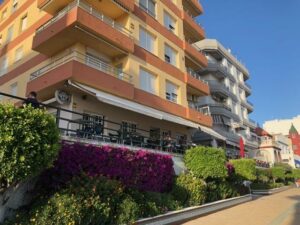 |
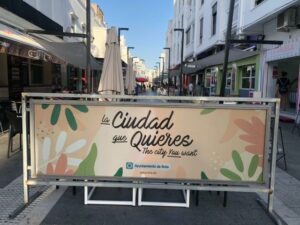 |
En Rota, es posible ver muchos anuncios que están en inglés y en español. |
| Algunos nombres de tiendas y lugares también están en inglés. Esta farmacia está cerca de mi casa.¡La farmacia está abierta las veinticuatro horas! Allí puedo comprar desde medicamentos hasta champú. El farmacéutico, Pepe, siempre hace recomendaciones a las personas que están enfermas. | |
 |
El Dia es uno de los supermercados más famosos de Rota. Allí mi madre compra la comida que va a preparar cada día. |
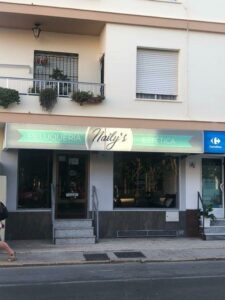 |
Desde pequeño, voy a la peluquería Naily’s. El corte de pelo cuesta sólo trece euros y los peluqueros siempre hacen un buen trabajo. |
| Para sacar dinero voy al cajero automático del banco BBVA. Siempre es bueno tener algo de dinero en efectivo. |
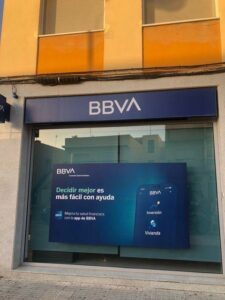 |
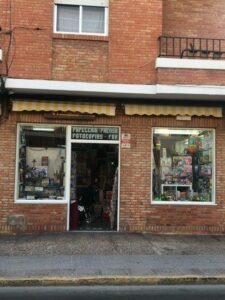 |
Cuando necesito hacer fotocopias, imprimir un documento o comprar algo para la escuela siempre voy a la papelería que está a cinco minutos de mi casa. ¡Me encantan los bolis que venden! |
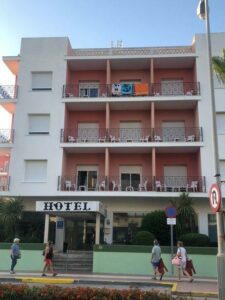 |
Hay muchos hoteles en Rota, desde pequeños hasta grandes. Las personas vienen principalmente en el mes de agosto de vacaciones. |
| Las playas en Rota son muy bonitas. La Playa de la Costilla es mi favorita. Me gusta porque está siempre limpia y el agua del mar es clara y la arena es muy fina. ¡Es perfecta para hacer castillos de arena! |
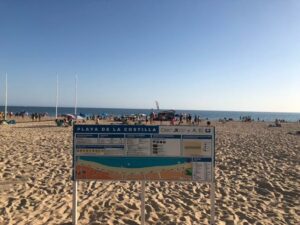 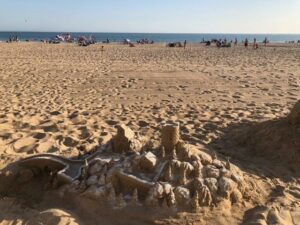 |
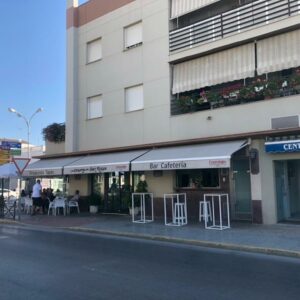 |
Después de un día en la playa, las personas en mi comunidad van a un bar a comer algunas tapas como gambas (shrimp), tortilla (Spanish omelette), carrillada (a type of beef dish), etc. En España los bares son diferentes que en los Estados Unidos porque son más similares a un restaurante. Es también común comer al aire libre en la terraza o en la calle. Mi familia y yo comemos en un bar por lo menos una vez a la semana. |
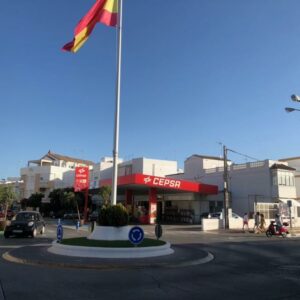 |
Las calles de Rota son estrechas y hay muchas rotondas. ¿Hay rotondas en tu comunidad? |
Answer the questions in complete sentences in Spanish.
- ¿Por qué Rota tiene una fuerte influencia de los Estados Unidos? ¿Cómo es visible esa influencia?
- ¿Cuándo están abiertas algunas farmacias en Rota?
- ¿Cúando hay más turistas en Rota? ¿Por qué?
- ¿Qué se puede hacer en la playa en Rota?
Actividad interpersonal 4.17. Rota y nuestra comunidad
Talk to a partner and discuss the similarities and differences between Rota and the community where your university is. By the end, be sure to have discussed at least two similarities and two differences.
Modelo:
En Rota, hay playas, y en nuestra comunidad, no hay una playa.
Actividad presentacional 4.18. Tu comunidad
Now that you have learned about Rota, write a short email response to Óliver describing your community. Be sure to include:
- Location. Where is your community located?
- Aspects that make your community unique.
- Activities that you and your family like to do.
- An appropriate greeting and closing.
V. Video entrevistas
Actividad interpretativa 4.19. Mi comunidad
Watch and listen to the videos in which native speakers of Spanish discuss special traditions in their communities. For each video, answer the following questions in complete sentences in Spanish.
1. Lisa:
a. ¿De dónde es?
b. ¿Cómo es su ciudad?
c. ¿Cómo es el transporte público?
d. ¿Cuáles son los platillos típicos de su ciudad?
e. ¿Cuál es una celebración importante que se celebra?
2. Mariangel:
a. ¿De dónde es?
b. ¿Cuál es una fiesta importante? ¿Cuándo se celebra?
c. ¿Cuáles son unas comidas típicas venezolanas?
3. Robin:
a. ¿De dónde es?
b. ¿Cómo es su ciudad? ¿Cómo es la geografía?
c. ¿Cuáles son unos pasatiempos populares de los habitantes?
d. ¿Cuántas provincias hay en Costa Rica?
e. ¿Cuál es un platillo típico costarricense? ¿Qué ingredientes hay en él?
f. ¿Cómo y cuándo se celebra la anexión de Liberia?
Actividad interpersonal 4.20. Preguntas personales
Watch and listen to the video of Mariangel asking questions about your community:
Pause the video after each question and prepare a response.
1.
2.
3.
4.
5.
Actividad interpretativa 4.21. El Día del Amor y la Amistad
Watch the following video about Manuela’s favorite holidays in Colombia:
Then answer the following questions.
Actividad interpretativa 4.22. La Navidad en México y Argentina
Watch and listen to the video in which native speakers of Spanish discuss how they celebrate Christmas (Navidad) in Argentina and Mexico:
Then fill out the following table to compare and contrast traditions. Be sure to include the following information:
- La estación y el clima durante Navidad
- Los platillos típicos navideños
- Otras fiestas importantes
Use the table below to help you describe the above topics or write your own words or phrases to take note of what you learn.
el frío
el calor
el invierno
el verano
el pozole
los postres
las empanadas
la cerveza
el jugo
el champurrado
las bebidas frías
las bebidas calientes
la rosca de reyes
los tamales el Día de Reyes Magos la Navidad
| Priscila—Argentina | Los dos | Tiffany—México |
Actividad presentacional 4.23. Una costumbre especial
Prepare a video response to one of the speakers by sharing about a special celebration or custom in your community or your family. Be sure to answer the following questions in your video response:
- ¿Cuál es la celebración? ¿Cuándo y dónde la celebras?
- ¿Qué comes para celebrar?
- ¿Qué actividades haces para celebrar?
- ¿Por qué es una celebración importante para ti?
VI. Gramática
4-A. The verb estar to express location
In the last chapter, we learned that the irregular verb estar is used to talk about emotions. In addition to emotions, the verb estar is also used to express where something or someone is located.
Examples:
La oficina de correos está al lado del banco.
El café está enfrente de la piscina.
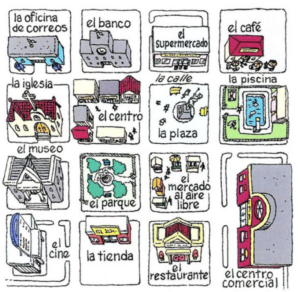
Notice that the verb estar is used with prepositions of location to indicate where something is.
| Do you remember the verb estar? | |
| Yo | Estoy |
| Tú | Estás |
| Él/Ella/Usted | Está |
| Nosotros/as | Estamos |
| Vosotros | Estáis |
| Ellos/Ellas/Ustedes | Están |
| Preposiciones – Para indicar localización | Prepositions – To indicate location |
| Abajo de | Below |
| Arriba de | On top of |
| Alrededor de | Around |
| Entre | Between |
| Sobre | On |
| Al lado de | Next to |
| A la derecha de | To the right of |
| A la izquierda de | To the left of |
| Cerca de | Close to |
| Lejos de | Far from |
| Delante de | In front of |
| Enfrente de | In front of but facing each other |
| Detrás de | Behind |
| Dentro de | Inside |
| Fuera de | Outside |
| Encima de | On top of |
| Recto | Straight |
The same structure is used in English to express location.
The post office is next to the bank. El correo está al lado del banco.
The café is in front of the pool. El café está enfrente de la piscina.
Actividad 4.24. ¿Dónde está?
Look at the image and then indicate where the following places are located.

Modelo:
El museo está entre la iglesia y el cine.
- El parque
- El centro comercial
- El cine
- El supermercado
- El restaurante
Actividad 4.25. ¿Qué lugar es?
Read the following descriptions and then look on the map to find the place indicated. Then write a complete sentence to identify the place, using the format from the model.
Modelo:
Está detrás de la iglesia y a la izquierda del banco.
Es la oficina de correos.
Actividad 4.26. La localización en mi comunidad
Think about your community and then answer the following questions.
Modelo:
¿Cuál es tu café favorito? ¿Dónde está?
Starbucks está en la avenida Main. Está al lado de Subway.
- ¿Cuál es tu restaurante favorito? ¿Dónde está?
- ¿Hay una farmacia cerca de la universidad? ¿Dónde está?
- ¿Dónde está la oficina de correos?
- ¿Tienes una panadería favorita? ¿Dónde está?
- ¿Hay un zoológico en tu ciudad? ¿Dónde está?
Actividad de investigación cultural 4.27. Mapas turísticos
You will learn about historic cities in the Spanish-speaking world and explore what attractions they have to offer.
Paso 1—Use one of the following links or find your own tourist map of a city. Be sure to find one that shows important tourist attractions such as museums, parks, and monuments. If you are doing your own search, try using the terms “mapa turístico de _____ (ciudad)” or “mapa del centro histórico de _______ (ciudad).”
- El centro histórico de Oaxaca (México): http://www.oaxaca.travel/index.php/es/sitios-de-interes/folletos/17-mapas
- Cartagena de Indias (Colombia): http://www.cartagenadeindias.travel/cargar_imagen.php?tipo=21&id=797&thumbnail=false
- La Habana Vieja (Cuba): http://www.particuba.info/villes/la_habana/habana_vieja/images/_mapas/_mapHav_Vieja_Totale.html
- Santo Domingo (La República Dominicana): https://www.godominicanrepublic.com/es/descargas/download-category/mapas/
Paso 2—Find three places on the map that you would like to visit. Take some time to look at the websites for the monuments. Then fill out the following information:
| Nombre del lugar | ¿Qué es? | ¿Por qué te interesa? |
| • Un museo
• Un parque • Un lugar histórico • Un mercado • Un lugar para recreación • ________________ |
||
| • Un museo
• Un parque • Un lugar histórico • Un mercado • Un lugar para recreación • ________________ |
||
| • Un museo
• Un parque • Un lugar histórico • Un mercado • Un lugar para recreación • ________________ |
Paso 3—Write some clues to help a classmate find the place on the map without naming the place directly. You should describe where it is (using the verb estar) as well as what kind of place it is.
1.
2.
3.
4.
5.
Paso 4—Share your clues with your classmate until they guess the place. Then share por qué te interesa. Then switch roles.
Actividad interpersonal 4.28. Una visita cultural
Now that you have researched some cities and their cultural offerings, you will plan a trip with a classmate. Speaking only in Spanish, pretend the two of you are traveling to a Spanish-speaking country and are planning to visit some historic sites.
You must decide:
- What city you will visit.
- When in the year you will go there.
- Three places you will go.
4-B. Estar para condiciones
The verb estar is used with past particles to describe states or conditions like a store being open or closed.
For example:
El cine está cerrado. The movie theater is closed.
La biblioteca está abierta hasta las diez de la mañana. The library is open until 10:00 a.m.
Cerrado and abierta are the past participles of the verbs cerrar and abrir that are working as adjectives to describe a state or condition. Since they are working as adjectives, they also have to agree in gender and number with the noun being described—in this case, the cine and the biblioteca.
The past participle of verbs is formed in the following manner:
For -ar verbs, drop the -ar ending and add -ado.
For -er and -ir verbs, drop the -er or the -ir and add -ido.
The following verbs have irregular past participles:
| Verb | Past participle |
| Abrir
Decir Escribir Hacer Morir Poner Ver Volver |
Abierto
Dicho Escrito Hecho Muerto Puesto Visto Vuelto |
Actividad 4.29. ¿Cómo está?
Look at the images below and describe the condition or state of the people, things, or places depicted in the images. Use a form of estar plus the participle of one of the verbs in the word bank. Make sure you pay attention to agreement.
| Modelo:
1. La chica está dormida.  |
2. El restaurante _____.
 |
3. El libro _____.

|
4. La carta _____.
 |
5. Las fotos _____.

|
6. Los boletos para el concierto _____.
 |
4-C. Los mandatos
When we hear the word commands, many times the first thing that comes to mind is an order given by someone in power to someone with less power, such as an explicit direction that a military commander would give to a member of the armed forces or a person telling their dog what to do. Commands, however, are not just used to issue orders. They are also used to give instructions and advice. Therefore, we might see commands in recipe books and advice columns, and they are also very common in everyday speech, since we are constantly giving advice or making recommendations.
How do you form a command?
It is necessary to use the imperative mood to form commands. In English, commands are formed by using the infinitive form of the verb without the to: take me there, buy me candy, go to sleep, take pictures, and so on. It does not matter whether you are talking to one person or a group of people, speaking to a close friend or a business associate. Spanish, on the other hand, does consider whether the command is given to an individual or to multiple people. It also takes into account the register, formal or informal, that must be used with that person or group of people.
In both English and Spanish, we use commands to ask people to do something with affirmative commands and not to do something with negative commands. Take a look at the following examples in English:
| Affirmative commands | Negative commands |
| Go to sleep.
Eat your vegetables. Do your homework. Open your books to page fifteen. Come on time for your appointment. Drive safely. |
Don’t stay up too late.
Don’t eat too much junk food. Don’t forget to do your homework. Don’t be lazy. Don’t arrive late. Don’t drive too fast. |
Mandatos informales
Informal commands are the ones given to people with whom we have a close or informal relationship. There are two possible types of informal commands: tú commands, which are given to an individual, and vosotros commands, which are given to a group of people. Let’s look at each type separately.
Tú commands
Tú commands are perhaps the most common type of command, since they are used with peers and people that we know well.
Affirmative tú commands
To form the affirmative tú command, use the third-person singular form of the present indicative. This is the he or she form. It also means that if you have an -ar verb, the command should end in -a, and for -er/-ir verbs, the ending should be an -e.
Examples:
| Verbo | Mandato |
| Comer | Come |
| Comprar | Compra |
| Beber | Bebe |
| Doblar | Dobla |
| Jugar | Juega |
There are also some verbs that have an irregular tú command:
| Tener | Ten | Have |
| Hacer | Haz | Do or make |
| Poner | Pon | Put |
| Decir | Di | Say or tell |
| Ir | Ve | Go |
| Salir | Sal | Leave or go out |
| Ser | Sé | Be |
| Venir | Ven | Come |
Let’s see some examples of these affirmative command forms in context:
Come las verduras.—Eat your vegetables.
Compra ropa de calidad.—Buy high-quality clothing.
Ten dinero en efectivo.—Have cash.
Haz la tarea.—Do your homework.
Sé bueno.—Be good.
Ven rápido.—Come quickly.
Negative tú commands
To form a negative tú command:
- Take the yo form of the verb in the present indicative.
- Drop the -o.
- Add the following (opposite) endings:
-ar, add -es
-er/-ir, add -as
- Put no before it.
Examples:
| Verb | Negative tú command |
| Comer | No comas |
| Salir | No salgas |
| Comprar | No compres |
| Tener | No tengas |
| Pedir | No pidas |
There are also irregular negative tú commands that you will have to memorize.
| Verbo | Irregular negative tú command – Español | Irregular negative tú command – English |
| Dar | No des | Don’t give |
| Ir | No vayas | Don’t go |
| Ser | No seas | Don’t be |
| Estar | No estés | Don’t be |
Let’s see some more examples, this time of negative tú commands:
No estés enojado.—Don’t be mad.
No vayas a la tienda por la noche.—Don’t go to the store at night.
No des tu número de teléfono a extraños.—Don’t give your phone number to strangers.
Actividad 4.30. Mandatos de tú
Actividad interpretativa 4.31. Guatemala: El país de la eterna primavera
Read the following text about Guatemala and then follow the prompts below.
Guatemala: El país de la eterna primavera

Aerial View of a City by Saulo Zayas licensed under Pexel License
¡Ven a Guatemala! Tiene un clima perfecto y no hay temperaturas extremas. También hay una gran diversidad de flora.
Sube a un volcán. Hay más de treinta y cinco volcanes de los cuales trece son visitados por turistas frecuentemente.
Toma una camioneta o bus en Guatemala. Las camionetas son autobuses escolares de los Estados Unidos muy coloridos y divertidos.
Visita Antigua. Es una ciudad colonial con edificios y monumentos de gran interés como el Palacio de los Capitanes Generales
Aprende sobre la cultura maya. Guatemala es conocida como el “Corazón del Mundo Maya” por ser unos de los principales lugares donde vivieron.
Bebe café y come platillos tradicionales como paches y shucos.
Ve al lago Atitlán y al mercado Santiago de Atitlán. Son dos lugares con mucha vida y color local.
No asumas que las cosas en Guatemala son como en los los Estados Unidos. Es otra cultura y hay cosas que se hacen diferentes.
No tomes fotos de las personas sin antes pedir permiso.
No esperes que todas las personas hablen español. Hay veintiún dialectos mayas en Guatemala y, por tanto, personas que hablan esos dialectos y no español.
No confíes (don’t trust) en desconocidos. Los turistas pueden ser víctimas de estafas (scams).

1. Subraya (underline) los mandatos afirmativos y negativos que encuentres.
2. ¿Cuál crees que es el objetivo del texto: dar órdenes, dar recomendaciones o dar instrucciones?
3. Escribe tres de las actividades recomendadas en Guatemala ¿Cuál de estas actividades te interesa más?
4. ¿Qué no se recomienda hacer en Guatemala? ¿Estás de acuerdo (do you agree)?
5. ¿Dónde puedes encontrar textos similares a este?
Actividad presentacional 4.32. Ven a mi comunidad
You are in charge of creating an information poster about why people should visit your community. You can choose to do it about your neighborhood, your state, or the United States. Use tú commands and make sure that you include the following:
- At least three activities that you recommend.
- At least three activities that you recommend not doing.
- Some images to make your description more appealing.
Actividad interpersonal 4.33. Indicaciones
Watch and listen to the video in which Manuela asks for directions to arrive at three different places in the community:
Prepare a response for each location in which you tell her how to get there using affirmative and negative tú commands. Use the list of location words in the Vocabulario section to help you as well as the following words.
| Doblar
Seguir Parar La cuadra |
To turn
To continue To stop (City) block |
Modelo:
¿Me indicas cómo llegar a la iglesia?
Ve recto a la calle 38. Después, dobla a la derecha y sigue por una cuadra. No vayas muy lejos. Está a la izquierda, entre el banco y unas casas.
1.
2.
3.
4-D. Vosotros commands
Vosotros commands are the informal commands that are given to a group of people. If you want to issue an order, make a recommendation, give advice, or give instructions to a group of people whom you address informally, then you would use a vosotros command. Vosotros is similar to saying y’all. Just like with the word y’all in English, it can be understood by most speakers of Spanish, but it is used by a smaller subset—mainly, individuals from Spain. Vosotros commands are commonly heard in Spain, but when not in Spain, ustedes is a more standard way to address a group of people directly. Therefore, ustedes commands are used.
Affirmative vosotros commands
Vosotros commands are formed by doing the following:
- Take the infinitive form of the verb: comer.
- Drop the final -r: come
- Add -d: comed
Here are some examples of how the vosotros command is formed:
| Verb | Vosotros command |
| Ir | Id |
| Escribir | Escribid |
| Ver | Ved |
Now, let’s see some examples of the affirmative vosotros command in context:
| English | |
| Read the instructions | Leed las instrucciones |
| Eat your food | Comed vuestra comida |
| Buy the tickets | Comprad los boletos |
Negative vosotros commands
Negative vosotros commands are formed in a way similar to negative tú commands:
- Take the yo form of the verb in the present indicative.
- Drop the -o.
- Add the following (opposite) endings:
-ar, add -éis
-er/-ir, add -áis - Put no before it.
| Verb | Negative vosotros command |
| Comer | No comáis |
| Salir | No salgáis |
| Comprar | No compréis |
| Tener | No tengáis |
| Pedir | No pidáis |
There are also irregular negative vosotros commands that you will have to memorize.
| Verbo | Irregular negative vosotros command |
| Dar | No déis |
| Ir | No vayáis |
| Ser | No seáis |
| Estar | No estéis |
Now, let’s see some examples of negative vosotros commands.
No llegáis tarde.—Don’t (you all) arrive late.
No tengáis miedo.—Don’t (you all) be afraid.
No habléis muy rápido.—Don’t (you all) speak too quickly.
Actividad 4.34. Los mandatos vosotros
Write the affirmative and negative vosotros command for the following verbs.
Modelo: Salir
Affirmative vosotros command: Salid
Negative vosotros command: No salgáis
Actividad 4.35. Las recomendaciones para ser mejores
Indicate what you recommend and do not recommend to your classmates according to the following categories.
Modelo:
Hacer algo para la mente (mind)
(Sí): Leed un buen libro
(No): No miréis la tele más de dos horas diarias
- Hacer algo positivo o bueno por los amigos
(Sí):
(No):
- Hacer algo bueno para el alma (soul)
(Sí):
(No):
- Hacer algo relacionado con el arte
(Sí):
(No):
- Hacer algo para cuidar de vuestro cuerpo (take care of your body)
(Sí):
(No):
- Hacer algo por la familia
(Sí):
(No):
Actividad presentacional 4.36. ¿Qué recomiendas?
You are in charge of giving recommendations to the freshman class about what to do or not to do to become part of your university’s community. Write a short speech welcoming the new class and offering some advice.
Make sure that you include the following:
- A greeting
- A personal introduction (who you are and why you are in a position to give advice)
- At least three things that you recommend doing
- At least three things that you do not recommend doing
- A closing
4-E. Object pronouns: Avoiding repetition
When we speak, we naturally try to make speech more fluid and avoid unnecessary repetition. One way that we do this is by replacing direct objects that have already been established with a pronoun. For example, look at the following sentences:
- I take the bus to school. I wait for it five minutes every day.
- I am going to make some coffee. I will drink it from my favorite mug.
Can you identify what the direct object is and how it is replaced to avoid repetition? Remember that the direct object identifies who or what receives the action of the verb. For number 1, the verb is to take; therefore, the question that one should ask is “What do I take?” The answer, “the bus,” is the direct object. The second sentence in number 1 replaces the direct object, “the bus,” with the pronoun it to avoid saying “the bus” again. For number 2, in the first sentence the verb is to make, so one should ask “What am I going to make?” to find the direct object. The answer is “coffee,” which then is also replaced with it in the second sentence.
In Spanish, just like in English, it is very common to avoid repeating the direct object by replacing it with a direct object pronoun. The direct project pronouns are the following:
| Pronombres de complemento directo | Direct object pronouns |
| Me | Me |
| Te | You |
| Lo | Him, it (masculine) |
| La | Her, it (feminine) |
| Nos | Us |
| Os | You all |
| Los | Them (masculine) |
| Las | Them (feminine) |
Since direct object pronouns replace the direct object (a noun), they have to agree in gender and number with the noun they are replacing.
See the following examples:
Ella bebe café. Lo prefiere frío.
She drinks coffee. She prefers it cold.
What does she drink? Coffee. Then coffee is the direct object. In Spanish, el café is a singular masculine noun, so we need lo to replace it.
Yo hablo con Laura frecuentemente. La veo casi todos los días.
I talk to Laura often. I see her almost every day.
Who do I speak with frequently? Laura. Then Laura is the direct object. Laura is a girl, and there is only one, so we would need la to replace her name.
Placement of direct object pronouns
While in English, object pronouns are usually placed directly after the verb, this is not the case in Spanish. Direct object pronouns can appear in two places:
- If there is one verb in the sentence, then the pronoun appears before the conjugated verb.
Example: Siempre me trae café. / She always brings me coffee.
- If there are two verbs in the sentence, it can appear:
a. Before the first conjugated verb.
Example: Lo voy a necesitar.
b. Attached to an infinitive.
Example: Voy a necesitarlo.
c. It cannot go between the conjugated verb and the infinitive.
Incorrect example: Voy a lo necesitar.
Actividad 4.37. Emparejar
Using a through e, match the initial statements listed first to the responses or second statements listed below based on the context.
Actividad 4.38. Sin repetición
Actividad 4.39. Las preguntas
Paso 1—Circle the direct object in each question.
Paso 2—Answer the questions and avoid repetition by replacing the direct object with a pronoun.
Modelo:
¿Vas a traer café a la reunión?
Sí, lo voy a traer.
- ¿Necesitas sacar dinero del cajero automático?
- ¿Vas a tomar fotos durante el espectáculo?
- ¿Necesitas enviar cartas por correo esta semana?
- ¿Vas a comprar juguetes para tus sobrinos?
- ¿Necesitas comprar analgésicos en la farmacia?
Actividad interpersonal 4.40. ¿Qué haces en tu comunidad?
Take turns with a partner asking and responding to questions about what you do in your community with family and friends. Make sure that you avoid repetition by replacing the direct object with a pronoun. As your partner answers, ask a follow-up question related to their response.
Modelo:
Estudiante 1: ¿Invitas a tus amigos a pasear por el centro de la ciudad frecuentemente?
Estudiante 2: Sí, los invito a pasear frecuentemente.
Estudiante 1: ¿Cuándo los invitas a pasear?
Estudiante 2: Los invito a pasear los viernes y sábados.
Ideas
- Invitar a los amigos a tomar un café
- Ver exposiciones de arte frecuentemente con amigos
- Hacer la compra con amigos/familiares
- Hacer voluntariado con amigos
- Comprar regalos para amigos o familia
4-F. Estrategias de comunicación: Expressing agreement and disagreement
Return to the tira cómica to answer the following questions:
- How does la madre de Ana respond when Ana says she is going to go to the market?
- How does Sra. Martínez express that her favorite part of having coffee at the market isn’t the coffee itself but rather the opportunity to socialize?
Just as the terms “I agree” and “I disagree” in English allow us to connect with what someone has said and express our own perspective in relation to it, Spanish has a similar structure. However, the phrase in Spanish differs in that we use the verb estar to say that “I am in agreement” or “I am not in agreement”: Estoy de acuerdo or No estoy de acuerdo.
Similar to this slight variation in Spanish, to express agreement by saying that someone is “right,” we say that that person “has reason,” tiene razón.
Tener razón—to be right No tener razón—to be wrong
Estar de acuerdo—to agree No estar de acuerdo—to disagree
For both of these structures as well as a variety of other ways of expressing opinion by agreeing or disagreeing, to make the statement negative, we add a no before the verb, not before the noun. So, whereas in English we would say “You are wrong,” in Spanish we say “No tienes razón.” Where in English we might say “That’s not true,” in Spanish we say “No es cierto.” Don’t forget to change the placement of the no, or ¡no tienes razón!
Remember that you can also show tacit agreement or disagreement by expressing a negative or positive opinion with the word qué.
| Words and phrases to show agreement | Words and phrases to show disagreement |
| Estoy de acuerdo. (I agree.) | No estoy de acuerdo. (I disagree. / I don’t agree.) |
| Tienes razón. (You’re right.) | No tienes razón. (You’re wrong.) |
| Es cierto. (It’s true. / That’s true.) | No es cierto. (It’s not true. / That’s not true.) |
| Es la verdad. (It’s the truth.) | No es la verdad. (It’s not the truth. / That’s not the truth.) |
| Yo también. (Me too.) | |
| Yo tampoco. (Me neither.) | |
| Es falso. (It’s false. / That’s false.) | |
| ¡Qué sí! (Yes!) | ¡Qué no! (No!) |
Actividad 4.41. ¿Estás de acuerdo?
Use the above phrases to express your personal agreement or disagreement with the following statements. Then explain.
Modelo:
La mejor estación del año es el verano.
Estoy de acuerdo. Me gusta el calor.
- Los gatos son mejores que los perros.
- Es importante dormir ocho horas cada noche.
- Todo el mundo debe correr para hacer ejercicio.
- Es necesario ir a la iglesia los domingos.
- La mejor estación del año es el invierno.
- El Día de la Independencia es la celebración cultural más importante en los Estados Unidos.
Actividad 4.42. ¿Lógico o ilógico?
Read the following statements and decide whether the given response of the person indicated is lógico o ilógico.
Modelo:
Es necesario hacer la tarea todas las semanas.
Un profesor dice “Estoy de acuerdo.”—lógico
4-G. Asking for and expressing opinions and recommendations: ¿Qué piensas?
¿Recuerdas cómo hacer preguntas? As you advance in your conversational proficiency, you will want to continually review the interrogative, or question, words in Spanish.
| Español | Inglés |
| ¿Qué? | What? |
| ¿Cuál? | Which? |
| ¿Cuándo? | When? |
| ¿Cómo? | How?/What? |
| ¿Dónde? | Where? |
| ¿Por qué? | Why? |
In chapter 2, you learned to use these words to learn more and to clarify information. These questions are also very important for continuing a conversation, with qué being one of the most important words you will use. In the previous section, you saw how to express agreement and disagreement. By asking for an opinion, you can expand even more your ability to discuss topics that are relevant to you as well as further your relationships with others.
| Key phrases for asking for opinions | Sentence starters to give an opinion |
| ¿Qué piensas? | Pienso que… |
| ¿Qué crees? | Creo que… |
| ¿Qué quieres? | Quiero… |
| ¿Qué prefieres? | Prefiero… |
You will also want to be able to respond to these questions and provide recommendations, opinions, and advice. There are many structures that can be used to make recommendations in Spanish, and one of them is simply starting with a verb that expresses an opinion, such as pienso or creo. Finally, to be more direct, you can say what someone should or you recommend they do using the verbs deber or recomendar.
Deber y recomendar
Just like with their meanings in English, should can express both objective realities that need to happen (Estoy en Starbucks. Debo pagar por mi café.) as well as more subjective recommendations (¡Debes venir al mercado! ¡Es divertido!). Recomendar expresses the recommendation a bit more explicitly than deber, of course. Deber is a regular -er verb and is conjugated for the person who needs to do the activity, just like the verb should in English:
I should study.—Debo estudiar.
They should practice soccer.—Deben practicar el fútbol.
Deber + infinitivo
| Debo estudiar. | Debemos ir a la panadería. |
| Debes venir al mercado conmigo. | Debéis escuchar a la profesora. |
| Miguel debe comer más vegetales. | Deben practicar el fútbol. |
Recomendar is a stem-changing -ar verb and is conjugated for the person making the recommendation.
Recomendar + infinitivo
Aconsejar + infinitivo
| Recomiendo estudiar. Hay un examen. | Recomendamos ir a la panadería. Es nuestra favorita. |
| ¿Recomiendas ir al mercado hoy? | ¿Recomendáis el restaurante al lado de vuestra casa? |
| El médico recomienda comer más vegetales. | Los entrenadores recomiendan practicar el fútbol. |
Impersonal expressions
Another way to express a recommendation for someone is to use the phrases “Es necesario” or “Es importante” prior to the activity. These impersonal expressions do not change depending on the person recommending or needing the recommendation. Instead, they express what needs to happen or what is important to do in general. Read the following bits of conversations to see how these expressions are used.
A: Mamá, tengo un dilema. Mis amigas y yo queremos salir a tomar un café pero no sabemos adónde queremos ir.
M: Deben ir al centro comercial. Hay muchos cafés muy buenos.
A: Gracias por la recomendación, Mamá. Estoy de acuerdo que son muy buenos. ¿Recomiendas un café en particular?
M: A mí me gusta mucho el café de Tinker.
A: Ah sí, ese café siempre está muy rico. Pero el lugar no está cerca de una parada de autobús. Para mis amigas y yo, es necesario usar el transporte público. No todas mis amigas tienen carros, y para mí, es importante cuidar el medio ambiente (environment).
M: Ajá, ahora veo el dilema. Pues, sé que hay un restaurante nuevo en el centro comercial al norte de la ciudad. La Señora García lo recomienda.
A: Pero Mamá, ¡toma una hora para llegar al norte en autobús!
M: Tienes razón. Aconsejo considerar tus prioridades antes de decidir.
A: ¡Ya sé! Mis amigas deben venir aquí a tomar un café. Pueden caminar y no necesitan pagar nada.
M: Creo que es una buena solución. Y tus amigas siempre son bienvenidas en casa.
Actividad interpretativa 4.43. Frases para recomendar
Make a list of the expressions used to make recommendations in the above dialogue.
Actividad 4.44. Conjugaciones de deber y recomendar
Conjugate deber and recomendar according to the following subjects.
Modelo:
Deber (vosotros)—debéis
Recomendar (ella)—recomienda
Actividad 4.45. ¿Deber o recomendar?
Read the situation and the two options and then select the most appropriate and logical response that you would have for the person given the situation. Answer from your perspective and pay attention to who is receiving the advice and who is giving it.
Modelo:
Tu mejor amiga tiene un examen mañana.
a. Debo estudiar.
b. Recomiendo estudiar.
Actividad 4.46. ¿Qué debo hacer?
Actividad interpersonal 4.47. Dando consejos
Listen to the following statements and provide two pieces of advice in writing. One of your statements should use debes, es importante, recomiendo, aconsejo, or es necesario. The other statement should use a tú command, either affirmative or negative, as necessary.
Modelo:
Estoy muy cansada.
a. Debes dormir más.
b. No juegues videojuegos hasta muy tarde.
- Tengo un examen mañana.
a.
b.
- Tengo mucha hambre.
a.
b.
- No hay más pan en la casa.
a.
b.
- Mi equipo de fútbol no gana muchos juegos.
a.
b.
- Es el verano y no hay clases.
a.
b.
Actividad de investigación cultural 4.48. Preparación para el mercado internacional
You will prepare to buy and sell items at an “international marketplace” during class time. Complete the following steps to be ready:
- Choose a type of store or stand from the following.
- Una heladería
- Una zapatería
- Una carnicería
- Una frutería
- Un café
- Una joyería
- Una tienda de ropa
- …
- Choose a Spanish-speaking country to represent for the market and learn what the currency is in that country. Then fill out the currency conversion chart with approximate equivalencies. Rounding is all right! Make sure you also learn the symbol associated with the country
- Draw, find photos of, or bring in physical items that you want to sell as part of your market stand. You must be able to describe each item in a complete sentence in Spanish and express how much it costs. Items may not cost more than $30 each.
Actividad 4.49. El mercado internacional
Paso 1—Together in class, students share the relative equivalencies of their currency. All students should write the correct numbers in their individual charts.
Paso 2—For the marketplace, students will need to (1) only use the target language, (2) have at least two negotiations before agreeing on the final price, and (3) record their sales and purchases. Together as a group, brainstorm some expressions students can use to ask for a different price. Think about all the phrases you have learned to make recommendations, express agreement and disagreement, and give commands.
Paso 3—Students will be divided into two groups. One group will start by selling and the other group will start by buying. Halfway through, students will switch places. Those who will be selling first should set up their market stands by their country’s flag.
Your instructor will have paper versions of the currency of each country represented available, including US dollars. Students will receive $100 each at the beginning of the round but will need to go to the banker to exchange the amount they want.
Paso 4—¡Se abre el mercado! The professor will serve as a banker. Be sure to have the copies of currency printed as well as a currency calculator ready to go. This converter works well: https://www.xe.com/currencyconverter/.
Currency equivalency chart
| País | Moneda y símbolo | $1 | $5 | $10 | $15 | $20 | $25 |
| Argentina | |||||||
| Bolivia | |||||||
| Chile | |||||||
| Colombia | |||||||
| Costa Rica | |||||||
| Cuba | |||||||
| Ecuador | |||||||
| España | |||||||
| Guatemala | |||||||
| Guinea Ecuatorial | |||||||
| Honduras | |||||||
| México | |||||||
| Nicaragua | |||||||
| Panamá | |||||||
| Paraguay | |||||||
| Perú | |||||||
| Puerto Rico | |||||||
| La República Dominicana | |||||||
| El Salvador | |||||||
| Uruguay | |||||||
| Venezuela |
Registro de compras
| Objeto y descripción | Precio original | Precio final |
| Una camisa blanca | 55 soles (PEN) | 40 soles |
Registro de ventas
| Objeto | Precio final de venta 1 | Precio final de venta 2 | Precio final de venta 3 | Ganancia total |
Actividad interpersonal 4.50. Lo que es necesario
In this activity, you will discuss what college students like you need to do to be successful in their studies, to maintain positive relationships, and to take an active role in their communities.
Paso 1—Using the model as an example, write a recommendation for a classmate regarding each of the categories below. Try to vary your sentences, using deber, recomendar, es necesario, and es importante. Be prepared to defend your recommendation. You will fill out the last two columns in pasos 2 and 3 after speaking with a classmate.
| Categoría | Recomendación | Opinión de mi compañero | ¿Estamos de acuerdo? |
| Modelo:
La comunidad |
Debemos comprar de tiendas locales | ||
| Los estudios | |||
| La familia | |||
| La vida sana | |||
| La comunidad |
Paso 2—Now, share your recommendations with your partner and take notes on their responses. After you share, they should express agreement or disagreement and justify their response. After each category, note whether you are in agreement or disagreement about what needs to be done.
Paso 3—Once you both have shared all recommendations and responses, choose the best recommendation overall that you both agree upon to share with the class.
Actividad interpersonal e interpretativa 4.51. Los gastos: ¿Cómo puedo mejor manejar mi dinero?
In this activity, you will discuss your spending habits with a partner and compare them to an infographic that makes recommendations about spending.
Paso 1—Take turns asking your partner and answering questions (sí o no) about spending habits using the following chart. Include two more things that you think your partner spends money on.
| Actividad | ¿Todos los días? | ¿Cada semana? | ¿Tres veces al mes? | ¿Dos veces al mes? | ¿Una vez al mes? | ¿Menos de una vez al mes? | ¿Cuánto pagas? |
| Vas a la heladería… | |||||||
| Comes en un restaurante… | |||||||
| Compras ropa nueva… | |||||||
| Vas al supermercado… | |||||||
| Compras un café o una bebida… | |||||||
| Compras en línea… | |||||||
Paso 2—Calcula el total que gasta tu compañero en cada categoría por mes. Luego, compara la información con tus gastos.
| Actividad o lugar | Gasto por mes de mi compañero | ¿Es más o menos de lo que gasto yo? |
| La heladería (u otras golosinas) | ||
| Los restaurantes | ||
| Las tiendas de ropa | ||
| El supermercado | ||
| Los cafés (incluyendo Starbucks) | ||
| Amazon u otros sitios web | ||
Paso 3—Leer y hacer recomendaciones. Follow along with your professor and your classmates as you read the infographic about habits that steal your money: https://www.blogylana.com/habitos-que-te-roban-dinero-infografia/. Which ones resonate with you?
Paso 4—Write three recommendations for your partner to better manage their money. Use any of the structures from the chapter:
Recomiendo… Es importante… Debes…
Paso 5—Get ready to share your recommendations with the class! As your classmates share, raise your hand if you agree with the recommendation your classmate is making.
Actividad interpersonal 4.52. ¿Cuál es más importante, el precio o el local?
You are going to participate in a debate about the relative importance of buying local. Your professor will assign you to one of the following groups.
Group A: This group will argue in favor of using sites like Amazon for most shopping.
Group B: This group will argue in favor of purchasing from locally owned businesses.
Paso 1—Together with your group, prepare a list of reasons to support your position.
Paso 2—Together with your group, anticipate what the other group’s reasons might be and think about how to respond to them. Consider reviewing how to express agreement/disagreement and recommendations.
Paso 3—¡Al debate! Follow your instructor’s lead to engage in a civil debate.
Paso 4—Reflexión personal. Now, take some time to write a brief reflection about your personal opinion on this issue.

